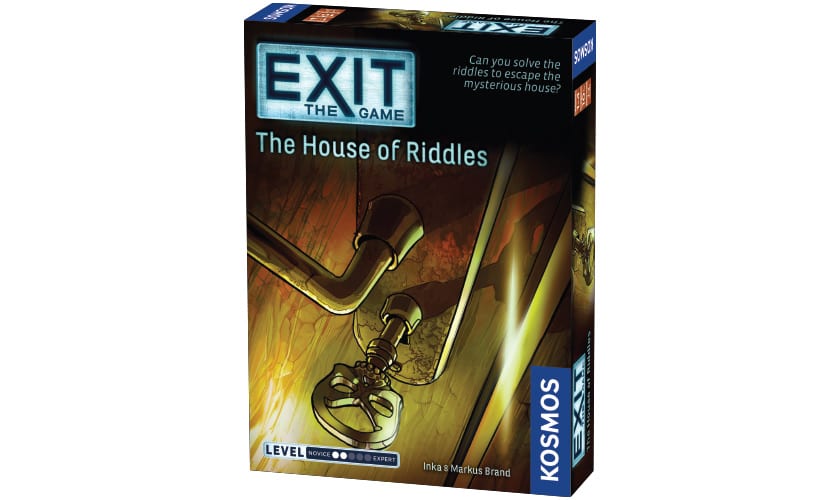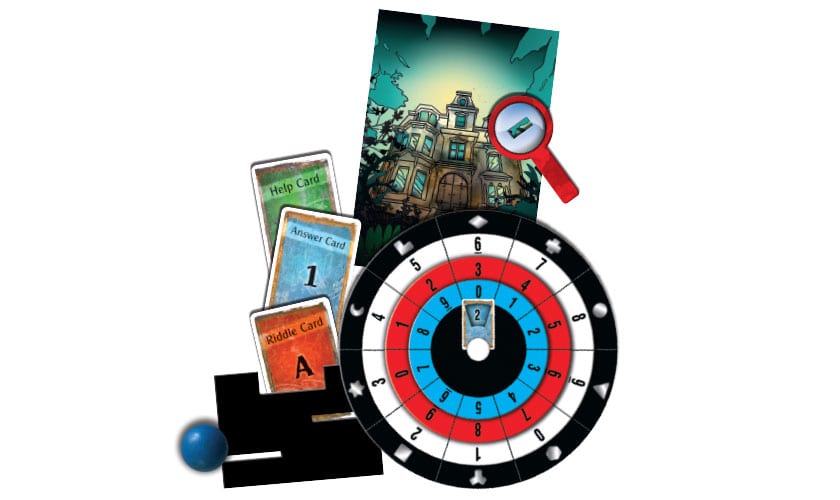The EXIT series of game from Thames & Kosmos are story-based puzzle games that are intended to be a sort of “escape room in a box.” Unlike the company’s similar Adventure Games series, the EXIT games have more of a horror bent, and can only be used once. The House of Riddles was released in 2019 and is rated 2/5 on the difficulty level, and revolves around an abandoned (and possibly haunted) house that players must try to escape.
As a note, we’ve tried our best to avoid spoilers but considering almost the entire game is a spoiler…we can’t guarantee there aren’t any here.
Box and Set Up

The box contains almost everything you will need for your escape room experience. It is recommended that you also have something to write on, something to write with, a black marker, and scissors. You will notice three types of cards: Riddle, Answer, and Hint. Each Riddle has three Hint cards, with an increasing level of helpfulness. For this reason it is important to make sure the decks are in order. You will be using the Answer cards a lot, so it helps to keep those in order during play as well. Do not fall prey to the familiar discard pile! The Decoder Wheel will be used for every riddle to lead to an Answer card. As for the other things in the box, don’t worry about them until you are told you have “found” them.
The one other thing in the box is the rulebook. The rulebook is your guide, and the closest you will get to a game board. As soon as you read that first line, the game is afoot!

Gameplay
While we can’t talk about too much here, for obvious spoiler reasons, we can talk about some of the basics. The general flow of the game is “entering a new room” (turning a page in the booklet) and revealing whichever riddle cards are listed. Someone reads the state of the room and what you are trying to accomplish within. Once the cards are revealed, you have everything you need to work through that room’s puzzle. Every room will give you three numbers and contain one symbol. These are arranged on the decoder disk and an answer card number is given. Someone checks that answer card and you find out if you’re right or wrong! There are some more advanced steps to this process, but that is the general game.
As a note, most of the answers are “possible” answers. That means that, when you go to check your answer, it will instead ask you which room you were in when you arrived at this answer card. Once you choose the corresponding room and card, it will then give you a definite correct or incorrect response. This helps prevent you from accidentally solving a puzzle too early, or simply beating your head against the decoder until you get a correct answer. You can of course simply keep trying random numbers over and over until you get a final answer, but if you are going to do that then honestly, why lock yourself inside in the first place?
Final Thoughts & Tips
Designate positions! We had one reader and one revealer, which helped both time-wise as well as understanding the puzzle. One person pulled the cards, the other read the puzzles and clues, and then the first went through the answer cards. This helps avoid fumbling over each other (which, to be fair, we also did a few times) and gives each team member a real sense of purpose. If you play this with the maximum players, this is even more recommended to help prevent one or two people blasting through the puzzles while others sit by and sort of get lost to the side. Each person having a specific role can make everyone feel included and give a sense of accomplishment when (if) you all make it out!
Don’t be afraid of hints. Going along with this, don’t get too cocky! Many of these puzzles are solved in drastically different ways, so naturally there will be some that seem extremely obvious and then at least a few that seem impossible. We hit a streak of two or three rooms that really clicked well with us, and then slammed into a wall of confusion. We got too caught up in our solving streak that it took us a few minutes to reconsider the puzzle in a different light. This led to our first Hint, which–as you can imagine with things like this–was immediately followed by an “OH, of course!” That one Hint refueled our confidence and helped us in a few rooms later on simply by reminding us of how much we had to change our viewpoint previously. Just remember: If you can’t see how a riddle should be solved, consider how you’re…interacting with that riddle.
Continuing that viewpoint thought, keep in mind that it’s okay to doubt your teammates, especially if you are all like-minded. Our first Hint came because we both thought the exact same (incorrect) way about a puzzle. If you think there is another way to approach something, voice your idea! Think of this game as a jigsaw puzzle where, once you lay down one piece, others will suddenly start seeing where their pieces go alongside yours. Every voice matters!
As a final gameplay note, we will echo something that the game itself tells you: Avoid distractions! Turn off phones, lock doors, whatever you need to do. It definitely helps if you start and finish this game in one solid run. If you aren’t too worried about authenticity, take snacks with you. Remember, you can only play this game once, so make the most of the experience!
We ended up finishing in a little over an hour and only needed two Hints, but this game was far from easy. We had our fair share of solving streaks and brick walls throughout. While we did pretty well for only our first time (and only two players!), it’s easy to see how addicting and challenging these games can become. And now with over a dozen adventures released, there are plenty of places for us to make an Exit!
(Due to the unique nature of the Exit series and each adventure, we will not be providing a standard rating for this game.)
You can pick up EXIT: The House of Riddles through Amazon or the Thames & Kosmos shop.
Thanks to Thames & Kosmos for the copy and images used in this review.

